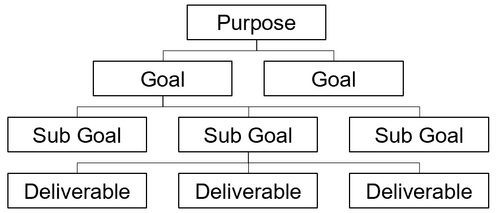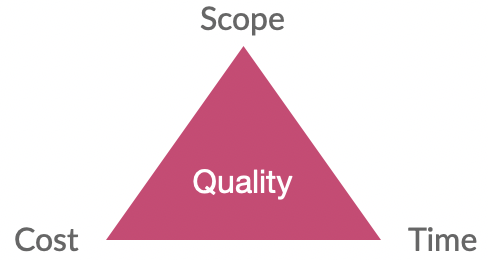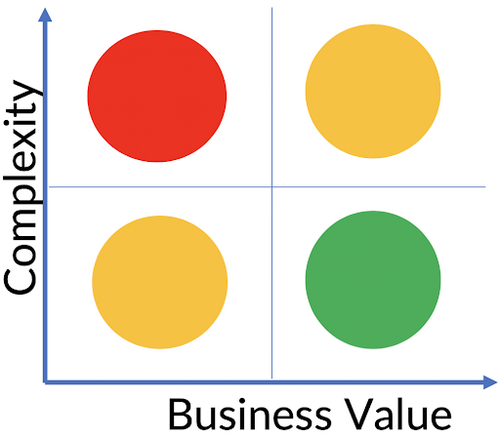PIMS Novo Nordisk 2020
(→Project charter) |
(→Uncertainty) |
||
| (43 intermediate revisions by one user not shown) | |||
| Line 1: | Line 1: | ||
| + | ==Abstract== | ||
| + | The following wiki article includes a brief description of a number of tools within project management. They are separated by four areas. Purpose, People, Complexity & Uncertainty. | ||
| − | + | __TOC__ | |
| − | + | ||
| − | + | ||
| − | + | ||
| − | + | ||
| − | + | ||
| − | + | ||
| − | + | ||
| − | + | ||
==Tools== | ==Tools== | ||
===Purpose=== | ===Purpose=== | ||
====Project charter==== | ====Project charter==== | ||
| − | The project charter lays the foundation of the project this can be divided into 4 different areas. | + | The project charter lays the foundation of the project this can be divided into 4 different areas. |
| + | <ref>''Project charter'', Retreived from https://www.projectmanagementdocs.com/template/project-initiation/project-charter-multi-page-version/#axzz4XoPzbU80</ref> | ||
*The project charter is used to define the scope, objective and vision of a project. This is done by describing the specific outcomes and how these will be achieved. | *The project charter is used to define the scope, objective and vision of a project. This is done by describing the specific outcomes and how these will be achieved. | ||
| Line 23: | Line 18: | ||
*The last part is budgeting and risks. Here the high level risks that apply to the project should be listed. Whit these information a budget can be made. | *The last part is budgeting and risks. Here the high level risks that apply to the project should be listed. Whit these information a budget can be made. | ||
| − | |||
====Value Proposition Canvas==== | ====Value Proposition Canvas==== | ||
| − | The Value Proposition Canvas, a part of Osterwalder and Pigneur’s Business Modell Canvas | + | The Value Proposition Canvas, a part of Osterwalder and Pigneur’s Business Modell Canvas <ref>''Business model Canvas'', Retreived from http://wiki.doing-projects.org/index.php/Use_of_Business_Model_Canvas_to_Kickstart_the_project_management</ref> |
| + | , can be used to clarify the project objectives and fully understand the customer needs. The right side of the model, the customer segment is sub dividable in; | ||
*Pains – unwanted things the customer could experience while getting the job done, e.g. extra cost, risks, and negative feelings towards the project | *Pains – unwanted things the customer could experience while getting the job done, e.g. extra cost, risks, and negative feelings towards the project | ||
*Gains – positive outcomes the customer wishes to achieve | *Gains – positive outcomes the customer wishes to achieve | ||
| Line 33: | Line 28: | ||
*Pain Relivers – how the project solves specific customer pains | *Pain Relivers – how the project solves specific customer pains | ||
*Gain Creators – how the project creates the intended gains for the customer | *Gain Creators – how the project creates the intended gains for the customer | ||
| − | *Product and Services – the services and products the project provides for the customer | + | *Product and Services – the services and products the project provides for the customer.<ref>''Value proposition design'', Retreived from http://www.orange.ngo/wp-content/uploads/2017/04/value-proposition-design.pdf</ref> |
| − | + | ||
| − | + | ||
| − | + | ||
| − | + | ||
| − | + | ||
| − | + | ||
| − | + | ||
| + | [[File:2canvas.png |500px|thumb|center|Value proposition canvas<ref>''Value proposition canvas'', Retreived from https://www.strategyzer.com/canvas/value-proposition-canvas</ref>]] | ||
====Goal Breakdown structure==== | ====Goal Breakdown structure==== | ||
Goal Breakdown Structure | Goal Breakdown Structure | ||
The purpose states why a project exists. However, the purpose needs to be translated in a strategy in order to achieve its benefits. | The purpose states why a project exists. However, the purpose needs to be translated in a strategy in order to achieve its benefits. | ||
| − | Therefore, the Goal Breakdown Structure (GBS) intends to divide projects, programs and portfolios overall purposes into manageable goals, sub-goals, and deliverables while maintaining the link to the overall objective. Whereas the Work Break Down Structure | + | Therefore, the Goal Breakdown Structure (GBS) intends to divide projects, programs and portfolios overall purposes into manageable goals, sub-goals, and deliverables while maintaining the link to the overall objective. Whereas the Work Break Down Structure <ref>''WBS'', Retreived from http://wiki.doing-projects.org/index.php/Work_Breakdown_Structure</ref> strives to translate purpose by the completion of tasks, the GBS is taking a different approach and is structuring the company by goals and objectives that may have measurable elements such as cost, time, etc. <ref>''GBS'', Retreived from https://ebookcentral-proquest-com.proxy.findit.dtu.dk/lib/dtudk/reader.action?docID=5180851#</ref> This goal hierarchy ensures the permanent alignment with the overall intention of the company. <ref>''Goal hierarchy'', Retreived from http://apppm.man.dtu.dk/index.php/Goal_hierarchy_or_Goal_Breakdown_Structure</ref> |
[[File:3gbs.png |500px|thumb|center|Goal breakdown structure]] | [[File:3gbs.png |500px|thumb|center|Goal breakdown structure]] | ||
| + | ===People=== | ||
| + | ====Situational leadership model==== | ||
| − | + | Paul Hersey and Ken Blanchard developed the theory of ‘situational leadership’ <ref>Hersey, P. & Blanchard, K. H. (1969). "Life cycle theory of leadership". Training and Development Journal. 23 (5): 26–34</ref> . The theory describes four different leadership styles and four levels of individual or team maturity or readiness. Depending on these two factors, suggest which style of leadership best suits which level of maturity. <ref>''Explanation of situational theory of leadership'', Retreived from https://www.verywellmind.com/what-is-the-situational-theory-of-leadership-2795321</ref> | |
| − | + | ||
| − | + | ||
| + | The leadership styles are: | ||
| + | *S1: Telling: one-way communication where the manager defines roles and is very directive about how work will be performed. | ||
| + | *S2: Selling: two-way communication. The team or individual is now encouraged to buy into the decisions being made by the manager. | ||
| + | *S3: Participating: shared decisions between individuals and the manager. | ||
| + | *S4: Delegating: manager delegate to individuals but retains responsibility for monitoring progress. | ||
| − | + | ||
| − | + | ||
| + | [[File:4leaderbehaviour.png |500px|thumb|center|Leadership style in terms of the amount of task behavior and relationship behavior. Graph based on <ref>Hersey, P. & Blanchard, K. H. (1969). "Life cycle theory of leadership". Training and Development Journal. 23 (5): 26–34</ref>]] | ||
====Meetings management and strategy==== | ====Meetings management and strategy==== | ||
| + | |||
| + | The purpose of these tools is to provide project managers a guide to consider and implement in projects but also to give them an understanding of the challenges that might occur and how to avoid them. One important benefit is that they will bring helps to identify how to communicate most effectively and efficiently, both internal in the project team and with stakeholders, saving project time and costs and on the same time keep project team members motivated. <ref>Rajkumar, S. (2010). Art of communication in project management. Paper presented at PMI® Research</ref> | ||
| + | |||
| + | |||
| + | '''Project life cycle phases''' | ||
| + | |||
| + | Splitting up a project into phases allows project management to plan and control progress throughout a project's life cycle and also prepare meetings identifying current challenges in one phase in relation to achieving the overall project goal. <ref>Project Management Institute. (2013). A guide to the Project Management Body of Knowledge (PMBOK® Guide)- Fifth Edition, Pennsylvania: Project Management Institute, Inc., p.589</ref> | ||
| + | |||
| + | |||
| + | [[File:51lifecycle.png |500px|thumb|center|Generic cycle based on the PMI’s Project Management Body of Knowledge (PMBoK)<ref>Project Management in Practice. McGraw-Hill 2013</ref>]] | ||
| + | |||
| + | Meetings in general al different and are used for example to share information on a specific subject, make decisions, provide updates, or brainstorm, among others. Each phase in the project has its own appropriate type of meeting. | ||
| + | |||
| + | [[File:52phases.png |500px|thumb|center|Relation between project life cycle and types of meetings<ref>Developed by Alice Allouche inspired in Duncan W. R., “A Guide to Project Management Body of Knowledge (PMBOK)”, PMI Standards Committee, (2013)</ref>]] | ||
====Project execution model (PEM)==== | ====Project execution model (PEM)==== | ||
| Line 65: | Line 74: | ||
#Idea – brief description of project objectives, stakeholders, resources (time, cost, personnel etc.), and risks to generate a basic understanding of the project | #Idea – brief description of project objectives, stakeholders, resources (time, cost, personnel etc.), and risks to generate a basic understanding of the project | ||
#Initiate – establishment of steering group to evaluate and give direction regarding project objective plus scope and further detailization of stage one topics. | #Initiate – establishment of steering group to evaluate and give direction regarding project objective plus scope and further detailization of stage one topics. | ||
| − | #Analyze – placement of key project team based on selected scope in stage two. Furthermore, creation of Work Breakdown Structure | + | #Analyze – placement of key project team based on selected scope in stage two. Furthermore, creation of Work Breakdown Structure <ref>''WBS'', Retreived from http://wiki.doing-projects.org/index.php/Work_Breakdown_Structure</ref>, refinement of risk management, and finalization of cost budget. |
#Execute –main project work carried out including preparations for transition from project phase to daily operation. | #Execute –main project work carried out including preparations for transition from project phase to daily operation. | ||
| − | #Realise – realization of benefits. ( | + | #Realise – realization of benefits. <ref>''PEM'', Retreived from http://wiki.doing-projects.org/index.php/Project_Execution_Model_(PEM)#PEM_-_a_five_gate_model</ref> |
| − | [[File:6pem.png |500px|thumb|center|Project Execution Model at Novo Nordisk | + | [[File:6pem.png |500px|thumb|center|Project Execution Model at Novo Nordisk <ref>''PEM'', Retreived from http://wiki.doing-projects.org/index.php/File:Image001.png</ref>]] |
{| class="wikitable" | {| class="wikitable" | ||
| Line 94: | Line 103: | ||
|} | |} | ||
| − | |||
| − | |||
| − | |||
| − | |||
====Expectations management==== | ====Expectations management==== | ||
| + | |||
| + | '''Theory of motivation''' | ||
| + | |||
| + | The Expectation Theory of Motivation was developed in 1964 by Victor H. Vroom.<ref>''Expectations management'', Retreived from http://wiki.doing-projects.org/index.php/Expectations_Management</ref>(1) | ||
| + | According to the theory, motivation happens when three variables are present: Expectancy, Instrumentality and valence. <ref>''Expectancy theory'', Retreived from https://expertprogrammanagement.com/2018/10/expectancy-theory/</ref> | ||
| + | |||
| + | |||
| + | [[File:71expectation.png |500px|thumb|center|3 variables]] | ||
| + | |||
| + | The individual makes choices based on motivation, expecting that an effort leads to performance that then gives an outcome with a valence. In motivation theory, valence is “the expected gratification of reaching a specific objective or result”<ref>''Motivation'', Retreived from https://psychologydictionary.org/valence/</ref> . In other words, valence is making sure that the reward is desired by the individual. According to theory, managers should create systems where added effort improves performance which results in a reward. | ||
| + | |||
| + | |||
| + | '''Iron triangle''' | ||
| + | |||
| + | The iron triangle (also called the project management triangle) has been used since the 1950’s. It is a metaphor showing interrelated constraints that the project manager has to trade-off while aiming for the best quality of the project’s product<ref>''Iron triangle'', Retreived from http://apppm.man.dtu.dk/index.php/Expectations_Management#Iron_Triangle</ref>. The constraints visualized in in each edge of the triangle are: Scope, time and cost <ref>''Constraints, iron triangle'', Retreived from https://www.pmi.org/learning/library/beyond-iron-triangle-year-zero-6381</ref>. In the middle is the quality of the project. The project manager should balance the constraints in order to get quality and success. It differs from project to project which constraints are most important.<ref>''Succes using the iron triangle'', Retreived from https://www.villanovau.com/resources/project-management/iron-triangle-project-management/</ref> | ||
| + | |||
| + | [[File:72iron.png |500px|thumb|center|Iron triangle]] | ||
| + | |||
| + | It is important to notice that the iron triangle is insufficient to define whether a project was/is a success, it is used as a helping tool for the project manager to get quality and success considering the constraints of the project. | ||
| + | |||
| + | '''Value vs complexity model''' | ||
| + | |||
| + | The Value vs complexity model is a prioritization tool for choosing among initiatives. | ||
| + | |||
| + | [[File:73valuecomplex.png|500px|thumb|center|Complexity matrix]] | ||
| + | |||
| + | The complexity matrix has a vertical axis representing complexity and a horizontal axis representing business value. You rate the business value and complexity of the initiative and visually mark the initiative in the quadrant <ref>''Iron triangle'', Retreived from http://apppm.man.dtu.dk/index.php/Expectations_Management#Iron_Triangle</ref>. Complexity could be cost, effort, technical challenge etc. Business value could be more visibility, satisfied customers, savings etc <ref>''Value vs complexity'', Retreived from https://medium.com/@ank.mahajan/value-vs-complexity-a-prioritisation-tool-4a2a1ba08eda</ref>(8). The greater the business value is and the lower complexity is the more prioritized is the initiative. This also works the other way around avoiding initiatives with a low business value that is complex to implement. | ||
====Project sponsor==== | ====Project sponsor==== | ||
| + | Being supported by a project sponsor (often referred to as the executive sponsor) is crucial to any project team and can make the difference between success and failure. Especially if your team is working as external consultants, it is often hard to determine who that is and what his or her interest are. | ||
| + | The responsibility of a project sponsor is to define the project and effectively communicate its overall benefit to the corporates strategy. Doing this, he or she has to balance all stakeholders' interests while letting the project manager manage the project without the sponsor getting involved into details and micromanagement. | ||
| + | |||
| + | [[File:8sponsor.PNG |500px|thumb|center|Sponsor map <ref>''Project Management Institute, Inc.. “Executive Engagement: The Role of the Sponsor”'', Retreived from https://www.pmi.org/-/media/pmi/documents/public/pdf/white-papers/executive-engagement.pdf?v=a5f338b0-39be-40e6-bb0e-2bba2f8dbfdb</ref>]] | ||
====Stakeholder map==== | ====Stakeholder map==== | ||
| − | After identifying the relevant stakeholders, they can be mapped in various ways. For example in a power vs interest matrix | + | After identifying the relevant stakeholders, they can be mapped in various ways. For example in a power vs interest matrix<ref>''Power vs interest'', Retreived from https://www.brighthubpm.com/resource-management/80523-what-is-the-powerinterest-grid/</ref> or mapping stakeholder benefits<ref>''Stakeholder benefits'', Retreived from https://project-management.com/what-is-stakeholder-analysis/</ref>. |
Using the tools as above or similar, gives a very good idea of what stakeholders interest are and how they can achieve them. In addition also how the stakeholders interests differentiate from each other. | Using the tools as above or similar, gives a very good idea of what stakeholders interest are and how they can achieve them. In addition also how the stakeholders interests differentiate from each other. | ||
Different positions in the power vs interest matrix corresponds to different managerial behaviour towards the specific stakeholder. Using this, paired with a stakeholder benefits analysis, gives a solid picture of the current stakeholder state. | Different positions in the power vs interest matrix corresponds to different managerial behaviour towards the specific stakeholder. Using this, paired with a stakeholder benefits analysis, gives a solid picture of the current stakeholder state. | ||
| − | |||
| − | |||
| − | |||
| − | |||
====Challenges in cross-cultural project management==== | ====Challenges in cross-cultural project management==== | ||
| + | Working in multicultural teams with members spread all over the globe, nowadays is as ordinary as using a smartphone and real time communication over thousands of kilometers. Especially in the context of an international university with students from over 102 different countries, the basic understanding of cultural differences in project work is fundamental. | ||
| + | To gain better knowledge on the effects of team members cultural values and how these values relate to specific behavior, Geert Hofstede developed a framework for cross-cultural communication. Based on a survey of employee values at IBM with more then 100,000 employees from across 70 countries, he developed his initial theory that got redefined since then. | ||
| + | |||
| + | The following model shows the 6 cultural dimensions along which national differences can be clustered. | ||
| + | [[File:910cultural.png |500px|thumb|center|Cultural dimensions<ref>''Wiki doing-projects: “Challenges in cross- cultural project management” '', Retreived from http://wiki.doing-projects.org/index.php/Challenges_in_cross-cultural_project_management</ref>]] | ||
===Complexity=== | ===Complexity=== | ||
====Project control==== | ====Project control==== | ||
| + | Project control is one of the 5 phases of a project displayed in figure below. Compared to the remaining 4 phases, control is the longest running task of the project. In the controlling phase all the aspects of the project are monitored and compared to the plan or KPIs. Usually the main concerns will be the control of the cost and time. However the controlling also involves the monitoring of risk and changes. <ref>DS/ISO 21500:2013 Danish Standards </ref> | ||
| − | |||
| − | |||
| − | |||
| − | |||
| − | |||
| − | + | [[File:911control.png |500px|thumb|center|Level of activity in the different project phases <ref>''Activity in different project phases'', Retreived from https://activecollab.com/blog/project-management/what-is-project-management</ref>]] | |
| − | ==== | + | ====Earned value analysis==== |
| − | + | ||
| − | + | ||
| − | + | ||
| − | + | ||
| − | + | ||
| − | + | ||
| − | ( | + | The earned value(EV) is used to measure the progress made in a project. Which then can be used to compare the planned value (PV) and the actual cost(AC) with the EV of the project according to the progres. |
| − | + | The earned value can be calculated as | |
| − | + | ||
| − | + | ||
| − | = | + | '''Earned Value (EV) = Total Budget x Work Progress''' |
| − | ''' | + | Along with the PV and the AC, it allows the project manager to get an overview of the financial status of the project. This is possible as the deviation between EV and PV expresses the deviation from the schedule and the difference between AC and EV is the cost variance. <ref>''Earned value'', Retreived from https://www.pmi.org/learning/library/earned-value-management-systems-analysis-8026</ref> |
| − | + | [[File:9115ev.png |500px|thumb|center|Earned value along with cost and schedule variance<ref>''Earned value figure'', Retreived from https://www.researchgate.net/figure/Fig-1Standard-Earned-Value-Analysis-Graph_fig1_265285339</ref>]] | |
| − | + | ===Uncertainty=== | |
| + | ====Risk management==== | ||
| + | All projects involve risks. Successful managing and identification of risks therefore plays a big role in any project. To map and categorize prior identified risk, a popular method is the risk matrix. <ref>''Risk matrix'', Retreived from https://www.cgerisk.com/knowledgebase/Risk_matrices</ref> | ||
| + | A typical risk matrix consist of two dimensions. How severe the consequences are if the risk occurs and how likely they are to occur. Using a matrix shows the project manager or controllers what risk’s to focus on. Thus makes it possible to decide if the risk is acceptable or it has to somehow be reduced to “as low as reasonably practicable” (ALARP)<ref>''ALARP'', Retreived from https://www.hse.gov.uk/risk/theory/alarpglance.htm#</ref> | ||
| + | As the project goes on, the landscape of risk may change. New risk’s may occur and probabilities can in- or decrease. It is therefore necessary to review the risk matrix and update it to show the current risk situation. | ||
| − | == | + | ====Change agent theory==== |
| − | + | In project teams with the role of the project manager is rotating, it is especially hard to facilitate change. The focus here is set on the team members motivation, where the project manager has the role to develop his or her team to a higher level of competency and performance by “helping people to recognize their potential through empowerment and development”. | |
| + | Acting as a coach is often the projects managers responsibility. Therefore the fundamental knowledge of coaching is crucial. | ||
| − | |||
| − | File: | + | [[File:913agent.png |500px|thumb|center|Recommended skills <ref>''Wiki doing-projects: “Coaching - Project Manager as Change Agent” '', Retreived from http://wiki.doing-projects.org/index.php/Coaching_-_Project_Manager_as_Change_Agent</ref>]] |
| − | + | ||
| − | + | In the process of developing the team, it is often helpful for the manager to see him or herself as a Change Agent whose role it is to move a persons mindset and attitude from the actual, undesired, stage to a improved strage in the future. | |
| − | + | ====Risk identification==== | |
| − | + | To manage risks, it is important to have identified and planned for as many risks as possible. If an unidentified risk occurs, the consequences may be much severe, as no actions are planned. | |
| − | + | To identify risks, a starting point can be to conduct a SWOT analysis or draw analogies and do research of other similar projects.<ref>''Risk identification tools'', Retreived from https://www.pmi.org/learning/library/risk-identification-life-cycle-tools-7784</ref> Later on, a more detailed identification can take place, for example assumptions analysis or interviews. To analyze root causes, a fishbone diagram or similar may be used. | |
| − | + | It is very difficult to ensure that all risks are taken into account. As projects usually include things that are unknown, some risks are also impossible to identify from the start. It is therefore very important to update and review the list of risks and their impact/frequency during the duration of the project. | |
| − | + | ||
| − | + | ||
| − | <ref> | + | |
| − | https:// | + | |
==References== | ==References== | ||
Latest revision as of 10:46, 8 March 2020
[edit] Abstract
The following wiki article includes a brief description of a number of tools within project management. They are separated by four areas. Purpose, People, Complexity & Uncertainty.
Contents |
[edit] Tools
[edit] Purpose
[edit] Project charter
The project charter lays the foundation of the project this can be divided into 4 different areas. [1]
- The project charter is used to define the scope, objective and vision of a project. This is done by describing the specific outcomes and how these will be achieved.
- In the organizing part the project team is defined along with the responsibility for the different participants. It also defines the relevant stakeholders.
- The implementation plan describes how the organization is going to succeed in fulfilling the objective described in 1. This usually involves timeline marking the different tasks and milestones during the project, the dependency among the different tasks and resousceplan.
- The last part is budgeting and risks. Here the high level risks that apply to the project should be listed. Whit these information a budget can be made.
[edit] Value Proposition Canvas
The Value Proposition Canvas, a part of Osterwalder and Pigneur’s Business Modell Canvas [2] , can be used to clarify the project objectives and fully understand the customer needs. The right side of the model, the customer segment is sub dividable in;
- Pains – unwanted things the customer could experience while getting the job done, e.g. extra cost, risks, and negative feelings towards the project
- Gains – positive outcomes the customer wishes to achieve
- Customer Jobs – all tasks the customer tries to perform and the problems they intend to solve
and used to exploit the project owners’ indentations, whereas the left side, the value proposition with its three subcategories, strives to describe the customer requirements.
- Pain Relivers – how the project solves specific customer pains
- Gain Creators – how the project creates the intended gains for the customer
- Product and Services – the services and products the project provides for the customer.[3]
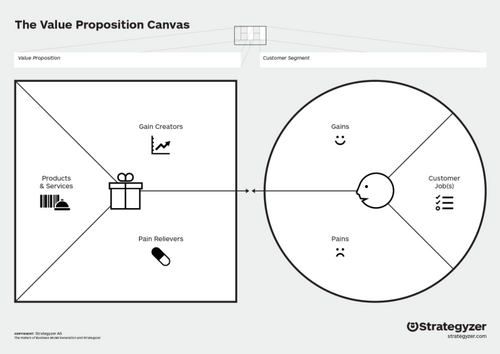
[edit] Goal Breakdown structure
Goal Breakdown Structure The purpose states why a project exists. However, the purpose needs to be translated in a strategy in order to achieve its benefits. Therefore, the Goal Breakdown Structure (GBS) intends to divide projects, programs and portfolios overall purposes into manageable goals, sub-goals, and deliverables while maintaining the link to the overall objective. Whereas the Work Break Down Structure [5] strives to translate purpose by the completion of tasks, the GBS is taking a different approach and is structuring the company by goals and objectives that may have measurable elements such as cost, time, etc. [6] This goal hierarchy ensures the permanent alignment with the overall intention of the company. [7]
[edit] People
[edit] Situational leadership model
Paul Hersey and Ken Blanchard developed the theory of ‘situational leadership’ [8] . The theory describes four different leadership styles and four levels of individual or team maturity or readiness. Depending on these two factors, suggest which style of leadership best suits which level of maturity. [9]
The leadership styles are:
- S1: Telling: one-way communication where the manager defines roles and is very directive about how work will be performed.
- S2: Selling: two-way communication. The team or individual is now encouraged to buy into the decisions being made by the manager.
- S3: Participating: shared decisions between individuals and the manager.
- S4: Delegating: manager delegate to individuals but retains responsibility for monitoring progress.
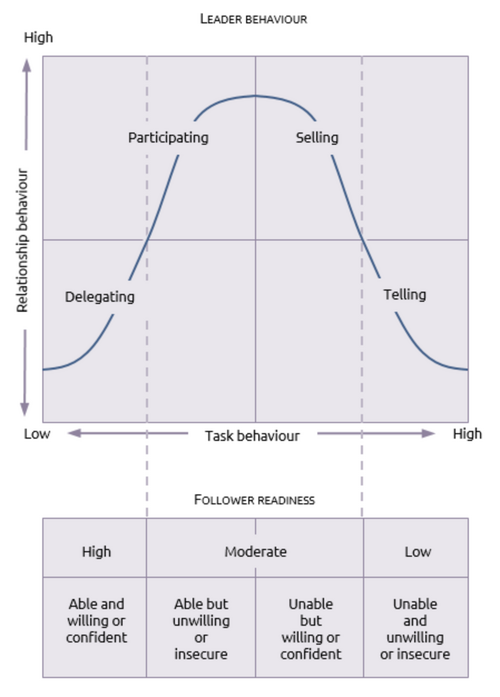
[edit] Meetings management and strategy
The purpose of these tools is to provide project managers a guide to consider and implement in projects but also to give them an understanding of the challenges that might occur and how to avoid them. One important benefit is that they will bring helps to identify how to communicate most effectively and efficiently, both internal in the project team and with stakeholders, saving project time and costs and on the same time keep project team members motivated. [11]
Project life cycle phases
Splitting up a project into phases allows project management to plan and control progress throughout a project's life cycle and also prepare meetings identifying current challenges in one phase in relation to achieving the overall project goal. [12]
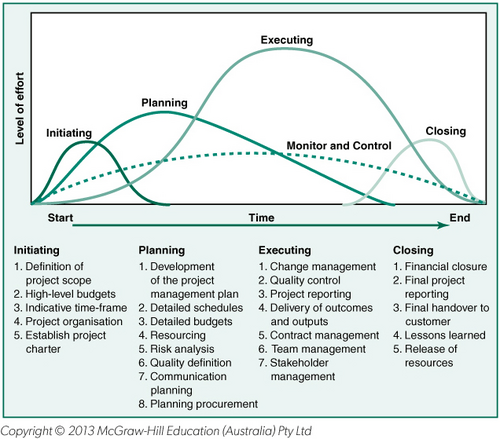
Meetings in general al different and are used for example to share information on a specific subject, make decisions, provide updates, or brainstorm, among others. Each phase in the project has its own appropriate type of meeting.
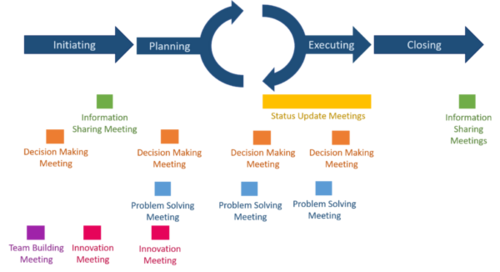
[edit] Project execution model (PEM)
The Project Execution Model is a five staged model used to guide the project manager in the activity. Each stage is followed by a gate where stakeholder such as project owners, project managers, steering groups and project sponsors review the completion of the previous stage in order to continue with the next phase or demand rework. The stages are:
- Idea – brief description of project objectives, stakeholders, resources (time, cost, personnel etc.), and risks to generate a basic understanding of the project
- Initiate – establishment of steering group to evaluate and give direction regarding project objective plus scope and further detailization of stage one topics.
- Analyze – placement of key project team based on selected scope in stage two. Furthermore, creation of Work Breakdown Structure [15], refinement of risk management, and finalization of cost budget.
- Execute –main project work carried out including preparations for transition from project phase to daily operation.
- Realise – realization of benefits. [16]

| Stakeholders | Responsibilities |
|---|---|
| Project Owner | Owns benefits and deliverables and appoints project manager |
| Project Manager | Day-to-day management of project execution |
| Steering Group (StG.) | Support during scoping and stage approval plus smoothening of project environment |
| Project Sponsor | Head of steering group, final approver of gate completion and overall investment cost |
| Project Team | Execution of project according to personal expertise |
| Line of Business | Internal corporate business unit to negotiate how to meet targets and resources with project manger |
[edit] Expectations management
Theory of motivation
The Expectation Theory of Motivation was developed in 1964 by Victor H. Vroom.[18](1) According to the theory, motivation happens when three variables are present: Expectancy, Instrumentality and valence. [19]
The individual makes choices based on motivation, expecting that an effort leads to performance that then gives an outcome with a valence. In motivation theory, valence is “the expected gratification of reaching a specific objective or result”[20] . In other words, valence is making sure that the reward is desired by the individual. According to theory, managers should create systems where added effort improves performance which results in a reward.
Iron triangle
The iron triangle (also called the project management triangle) has been used since the 1950’s. It is a metaphor showing interrelated constraints that the project manager has to trade-off while aiming for the best quality of the project’s product[21]. The constraints visualized in in each edge of the triangle are: Scope, time and cost [22]. In the middle is the quality of the project. The project manager should balance the constraints in order to get quality and success. It differs from project to project which constraints are most important.[23]
It is important to notice that the iron triangle is insufficient to define whether a project was/is a success, it is used as a helping tool for the project manager to get quality and success considering the constraints of the project.
Value vs complexity model
The Value vs complexity model is a prioritization tool for choosing among initiatives.
The complexity matrix has a vertical axis representing complexity and a horizontal axis representing business value. You rate the business value and complexity of the initiative and visually mark the initiative in the quadrant [24]. Complexity could be cost, effort, technical challenge etc. Business value could be more visibility, satisfied customers, savings etc [25](8). The greater the business value is and the lower complexity is the more prioritized is the initiative. This also works the other way around avoiding initiatives with a low business value that is complex to implement.
[edit] Project sponsor
Being supported by a project sponsor (often referred to as the executive sponsor) is crucial to any project team and can make the difference between success and failure. Especially if your team is working as external consultants, it is often hard to determine who that is and what his or her interest are.
The responsibility of a project sponsor is to define the project and effectively communicate its overall benefit to the corporates strategy. Doing this, he or she has to balance all stakeholders' interests while letting the project manager manage the project without the sponsor getting involved into details and micromanagement.
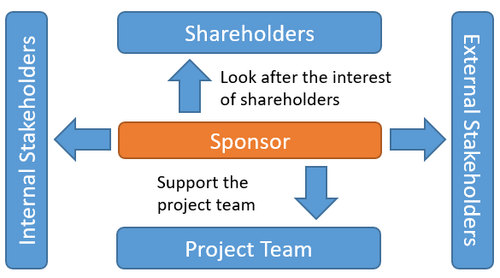
[edit] Stakeholder map
After identifying the relevant stakeholders, they can be mapped in various ways. For example in a power vs interest matrix[27] or mapping stakeholder benefits[28]. Using the tools as above or similar, gives a very good idea of what stakeholders interest are and how they can achieve them. In addition also how the stakeholders interests differentiate from each other. Different positions in the power vs interest matrix corresponds to different managerial behaviour towards the specific stakeholder. Using this, paired with a stakeholder benefits analysis, gives a solid picture of the current stakeholder state.
[edit] Challenges in cross-cultural project management
Working in multicultural teams with members spread all over the globe, nowadays is as ordinary as using a smartphone and real time communication over thousands of kilometers. Especially in the context of an international university with students from over 102 different countries, the basic understanding of cultural differences in project work is fundamental. To gain better knowledge on the effects of team members cultural values and how these values relate to specific behavior, Geert Hofstede developed a framework for cross-cultural communication. Based on a survey of employee values at IBM with more then 100,000 employees from across 70 countries, he developed his initial theory that got redefined since then.
The following model shows the 6 cultural dimensions along which national differences can be clustered.
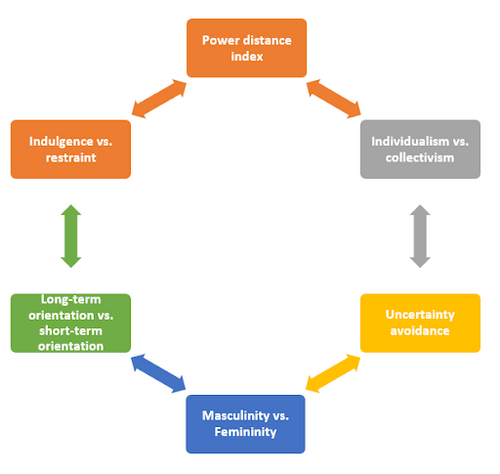
[edit] Complexity
[edit] Project control
Project control is one of the 5 phases of a project displayed in figure below. Compared to the remaining 4 phases, control is the longest running task of the project. In the controlling phase all the aspects of the project are monitored and compared to the plan or KPIs. Usually the main concerns will be the control of the cost and time. However the controlling also involves the monitoring of risk and changes. [30]
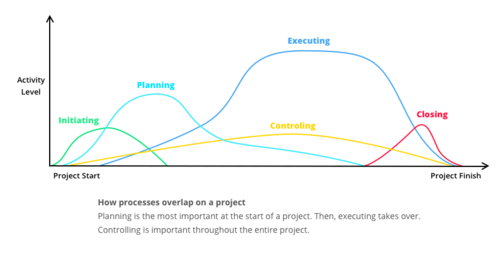
[edit] Earned value analysis
The earned value(EV) is used to measure the progress made in a project. Which then can be used to compare the planned value (PV) and the actual cost(AC) with the EV of the project according to the progres.
The earned value can be calculated as
Earned Value (EV) = Total Budget x Work Progress
Along with the PV and the AC, it allows the project manager to get an overview of the financial status of the project. This is possible as the deviation between EV and PV expresses the deviation from the schedule and the difference between AC and EV is the cost variance. [32]
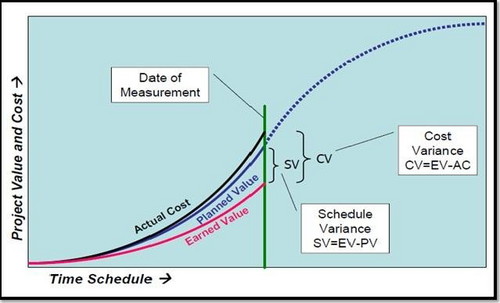
[edit] Uncertainty
[edit] Risk management
All projects involve risks. Successful managing and identification of risks therefore plays a big role in any project. To map and categorize prior identified risk, a popular method is the risk matrix. [34] A typical risk matrix consist of two dimensions. How severe the consequences are if the risk occurs and how likely they are to occur. Using a matrix shows the project manager or controllers what risk’s to focus on. Thus makes it possible to decide if the risk is acceptable or it has to somehow be reduced to “as low as reasonably practicable” (ALARP)[35] As the project goes on, the landscape of risk may change. New risk’s may occur and probabilities can in- or decrease. It is therefore necessary to review the risk matrix and update it to show the current risk situation.
[edit] Change agent theory
In project teams with the role of the project manager is rotating, it is especially hard to facilitate change. The focus here is set on the team members motivation, where the project manager has the role to develop his or her team to a higher level of competency and performance by “helping people to recognize their potential through empowerment and development”. Acting as a coach is often the projects managers responsibility. Therefore the fundamental knowledge of coaching is crucial.
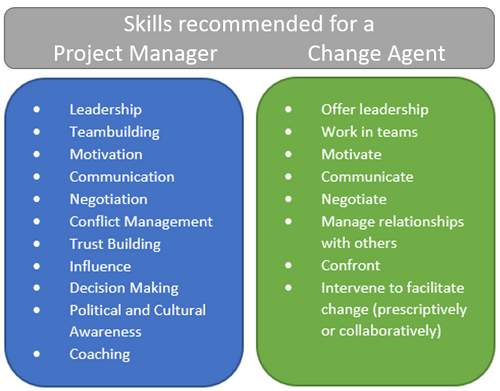
In the process of developing the team, it is often helpful for the manager to see him or herself as a Change Agent whose role it is to move a persons mindset and attitude from the actual, undesired, stage to a improved strage in the future.
[edit] Risk identification
To manage risks, it is important to have identified and planned for as many risks as possible. If an unidentified risk occurs, the consequences may be much severe, as no actions are planned. To identify risks, a starting point can be to conduct a SWOT analysis or draw analogies and do research of other similar projects.[37] Later on, a more detailed identification can take place, for example assumptions analysis or interviews. To analyze root causes, a fishbone diagram or similar may be used. It is very difficult to ensure that all risks are taken into account. As projects usually include things that are unknown, some risks are also impossible to identify from the start. It is therefore very important to update and review the list of risks and their impact/frequency during the duration of the project.
[edit] References
- ↑ Project charter, Retreived from https://www.projectmanagementdocs.com/template/project-initiation/project-charter-multi-page-version/#axzz4XoPzbU80
- ↑ Business model Canvas, Retreived from http://wiki.doing-projects.org/index.php/Use_of_Business_Model_Canvas_to_Kickstart_the_project_management
- ↑ Value proposition design, Retreived from http://www.orange.ngo/wp-content/uploads/2017/04/value-proposition-design.pdf
- ↑ Value proposition canvas, Retreived from https://www.strategyzer.com/canvas/value-proposition-canvas
- ↑ WBS, Retreived from http://wiki.doing-projects.org/index.php/Work_Breakdown_Structure
- ↑ GBS, Retreived from https://ebookcentral-proquest-com.proxy.findit.dtu.dk/lib/dtudk/reader.action?docID=5180851#
- ↑ Goal hierarchy, Retreived from http://apppm.man.dtu.dk/index.php/Goal_hierarchy_or_Goal_Breakdown_Structure
- ↑ Hersey, P. & Blanchard, K. H. (1969). "Life cycle theory of leadership". Training and Development Journal. 23 (5): 26–34
- ↑ Explanation of situational theory of leadership, Retreived from https://www.verywellmind.com/what-is-the-situational-theory-of-leadership-2795321
- ↑ Hersey, P. & Blanchard, K. H. (1969). "Life cycle theory of leadership". Training and Development Journal. 23 (5): 26–34
- ↑ Rajkumar, S. (2010). Art of communication in project management. Paper presented at PMI® Research
- ↑ Project Management Institute. (2013). A guide to the Project Management Body of Knowledge (PMBOK® Guide)- Fifth Edition, Pennsylvania: Project Management Institute, Inc., p.589
- ↑ Project Management in Practice. McGraw-Hill 2013
- ↑ Developed by Alice Allouche inspired in Duncan W. R., “A Guide to Project Management Body of Knowledge (PMBOK)”, PMI Standards Committee, (2013)
- ↑ WBS, Retreived from http://wiki.doing-projects.org/index.php/Work_Breakdown_Structure
- ↑ PEM, Retreived from http://wiki.doing-projects.org/index.php/Project_Execution_Model_(PEM)#PEM_-_a_five_gate_model
- ↑ PEM, Retreived from http://wiki.doing-projects.org/index.php/File:Image001.png
- ↑ Expectations management, Retreived from http://wiki.doing-projects.org/index.php/Expectations_Management
- ↑ Expectancy theory, Retreived from https://expertprogrammanagement.com/2018/10/expectancy-theory/
- ↑ Motivation, Retreived from https://psychologydictionary.org/valence/
- ↑ Iron triangle, Retreived from http://apppm.man.dtu.dk/index.php/Expectations_Management#Iron_Triangle
- ↑ Constraints, iron triangle, Retreived from https://www.pmi.org/learning/library/beyond-iron-triangle-year-zero-6381
- ↑ Succes using the iron triangle, Retreived from https://www.villanovau.com/resources/project-management/iron-triangle-project-management/
- ↑ Iron triangle, Retreived from http://apppm.man.dtu.dk/index.php/Expectations_Management#Iron_Triangle
- ↑ Value vs complexity, Retreived from https://medium.com/@ank.mahajan/value-vs-complexity-a-prioritisation-tool-4a2a1ba08eda
- ↑ Project Management Institute, Inc.. “Executive Engagement: The Role of the Sponsor”, Retreived from https://www.pmi.org/-/media/pmi/documents/public/pdf/white-papers/executive-engagement.pdf?v=a5f338b0-39be-40e6-bb0e-2bba2f8dbfdb
- ↑ Power vs interest, Retreived from https://www.brighthubpm.com/resource-management/80523-what-is-the-powerinterest-grid/
- ↑ Stakeholder benefits, Retreived from https://project-management.com/what-is-stakeholder-analysis/
- ↑ Wiki doing-projects: “Challenges in cross- cultural project management” , Retreived from http://wiki.doing-projects.org/index.php/Challenges_in_cross-cultural_project_management
- ↑ DS/ISO 21500:2013 Danish Standards
- ↑ Activity in different project phases, Retreived from https://activecollab.com/blog/project-management/what-is-project-management
- ↑ Earned value, Retreived from https://www.pmi.org/learning/library/earned-value-management-systems-analysis-8026
- ↑ Earned value figure, Retreived from https://www.researchgate.net/figure/Fig-1Standard-Earned-Value-Analysis-Graph_fig1_265285339
- ↑ Risk matrix, Retreived from https://www.cgerisk.com/knowledgebase/Risk_matrices
- ↑ ALARP, Retreived from https://www.hse.gov.uk/risk/theory/alarpglance.htm#
- ↑ Wiki doing-projects: “Coaching - Project Manager as Change Agent” , Retreived from http://wiki.doing-projects.org/index.php/Coaching_-_Project_Manager_as_Change_Agent
- ↑ Risk identification tools, Retreived from https://www.pmi.org/learning/library/risk-identification-life-cycle-tools-7784
